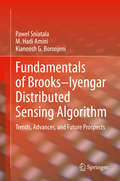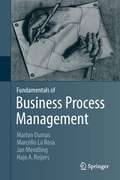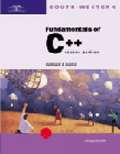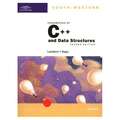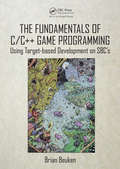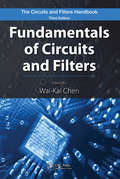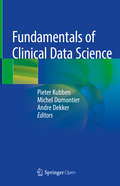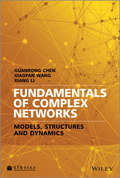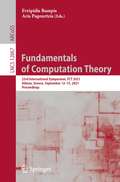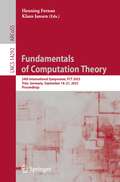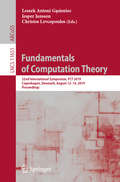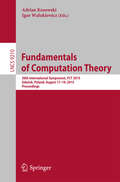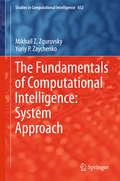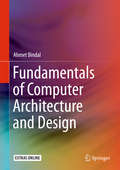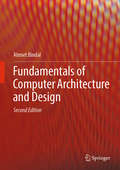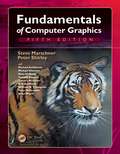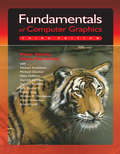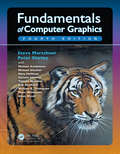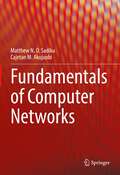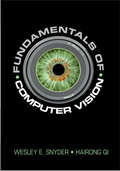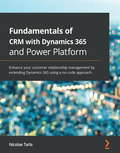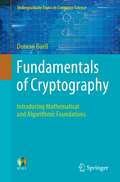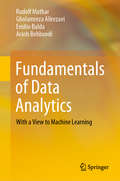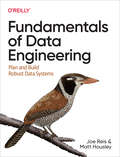- Table View
- List View
Fundamentals of Brooks–Iyengar Distributed Sensing Algorithm: Trends, Advances, and Future Prospects
by Kianoosh G. Boroojeni M. Hadi Amini Pawel SniatalaThis book provides a comprehensive analysis of Brooks-Iyengar Distributed Sensing Algorithm, which brings together the power of Byzantine Agreement and sensor fusion in building a fault-tolerant distributed sensor network. The authors analyze its long-term impacts, advances, and future prospects. The book starts by discussing the Brooks-Iyengar algorithm, which has made significant impact since its initial publication in 1996. The authors show how the technique has been applied in many domains such as software reliability, distributed systems and OS development, etc. The book exemplifies how the algorithm has enhanced new real-time features by adding fault-tolerant capabilities for many applications. The authors posit that the Brooks-Iyengar Algorithm will to continue to be used where fault-tolerant solutions are needed in redundancy system scenarios.This book celebrates S.S. Iyengar's accomplishments that led to his 2019 Institute of Electrical and Electronics Engineers' (IEEE) Cybermatics Congress "Test of Time Award" for his work on creating Brooks-Iyengar Algorithm and its impact in advancing modern computing.
Fundamentals of Business Process Management
by Marlon Dumas Marcello La Rosa Jan Mendling Hajo A. ReijersBusiness Process Management (BPM) is the art and science of how work should be performed in an organization in order to ensure consistent outputs and to take advantage of improvement opportunities, e.g. reducing costs, execution times or error rates. Importantly, BPM is not about improving the way individual activities are performed, but rather about managing entire chains of events, activities and decisions that ultimately produce added value for an organization and its customers.This textbook encompasses the entire BPM lifecycle, from process identification to process monitoring, covering along the way process modelling, analysis, redesign and automation. Concepts, methods and tools from business management, computer science and industrial engineering are blended into one comprehensive and inter-disciplinary approach. The presentation is illustrated using the BPMN industry standard defined by the Object Management Group and widely endorsed by practitioners and vendors worldwide. In addition to explaining the relevant conceptual background, the book provides dozens of examples, more than 100 hands-on exercises – many with solutions – as well as numerous suggestions for further reading. The textbook is the result of many years of combined teaching experience of the authors, both at the undergraduate and graduate levels as well as in the context of professional training. Students and professionals from both business management and computer science will benefit from the step-by-step style of the textbook and its focus on fundamental concepts and proven methods. Lecturers will appreciate the class-tested format and the additional teaching material available on the accompanying website fundamentals-of-bpm.org.
Fundamentals of Business Process Management
by Marlon Dumas Hajo A. Reijers Jan Mendling Marcello La RosaBusiness Process Management (BPM) is the art and science of how work should be performed in an organization in order to ensure consistent outputs and to take advantage of improvement opportunities, e.g. reducing costs, execution times or error rates. Importantly, BPM is not about improving the way individual activities are performed, but rather about managing entire chains of events, activities and decisions that ultimately produce added value for an organization and its customers. This textbook encompasses the entire BPM lifecycle, from process identification to process monitoring, covering along the way process modelling, analysis, redesign and automation. Concepts, methods and tools from business management, computer science and industrial engineering are blended into one comprehensive and inter-disciplinary approach. The presentation is illustrated using the BPMN industry standard defined by the Object Management Group and widely endorsed by practitioners and vendors worldwide. In addition to explaining the relevant conceptual background, the book provides dozens of examples, more than 100 hands-on exercises - many with solutions - as well as numerous suggestions for further reading. The textbook is the result of many years of combined teaching experience of the authors, both at the undergraduate and graduate levels as well as in the context of professional training. Students and professionals from both business management and computer science will benefit from the step-by-step style of the textbook and its focus on fundamental concepts and proven methods. Lecturers will appreciate the class-tested format and the additional teaching material available on the accompanying website fundamentals-of-bpm.org.
Fundamentals of C++: Introductory Course (2nd Edition)
by Kenneth Lambert Douglas W. NanceFollowing the success of Fundamentals of C++ by Lambert and Nance, C++ Introductory course is essential for a first course in Computer Science. Completely updated, this text provides in-depth coverage to help students prepare for the AP exam, Exam A. A full introduction to the essential features of C++ is provided and programming techniques are emphasized in the context of interesting and realistic case problems. This text is compatible with C++ compilers from Microsoft, Borland, and Metrowerks.
Fundamentals of C++ and Data Structures, Advanced Course (2nd Edition)
by Kenneth Lambert Thomas NapsFollowing the success of Fundamentals of Program Design and Data Structures by Lambert and Naps, C++ Advanced Course is essential for a second course in Computer Science. Completely updated, this text provides in-depth coverage to help students prepare for the AP exam, Exam AB. A full introduction to the essential features of C++ is provided and programming techniques are emphasized in the context of interesting and realistic case problems. This text is compatible with C++ compilers from Microsoft, Borland, and Metrowerks.
The Fundamentals of C/C++ Game Programming: Using Target-based Development on SBC's
by Brian BeukenThis book is aimed at giving novice coders an understanding of the methods and techniques used in professional games development. Designed to help develop and strengthen problem solving and basic C/C++ skills, it also will help to develop familiarity targeting and using fixed/restricted hardware, which are key skills in console development. It allows the reader to increase their confidence as game programmers by walking them through increasingly involved game concepts, while maintaining the understanding that despite the increased complexity, the core methods remain consistent with the advancement of the technology; the technology only enhances the gaming experience. It also demonstrates underlying principles of game coding in practical step by step ways to increase exposure and confidence in game coding concepts. Key Features: Increases the confidence of new coders by demonstrating how to get things done. Introduces evolving projects to reinforce concepts, both directly and indirectly that the reader will use to produce and then enhance the project. Provides tutorials on Graphics API’s that can be easily understood by a novice. Demystifies hardware used to gain new effects without blinding the user to the technical wizardry going on under the system. Gives a sense of achievement to the reader and pushes them toward improvement.
Fundamentals of Circuits and Filters (The Circuits and Filters Handbook, 3rd Edition)
by Wai-Kai ChenThis volume, drawn from the Circuits and Filters Handbook, focuses on mathematics basics; circuit elements, devices, and their models; and linear circuit analysis. It examines Laplace transformation, Fourier methods for signal analysis and processing, z-transform, and wavelet transforms. It also explores network laws and theorems, terminal and port represetnation, analysis in the frequency domain, and more.
Fundamentals of Clinical Data Science
by Pieter Kubben Michel Dumontier Andre DekkerThis open access book comprehensively covers the fundamentals of clinical data science, focusing on data collection, modelling and clinical applications. Topics covered in the first section on data collection include: data sources, data at scale (big data), data stewardship (FAIR data) and related privacy concerns. Aspects of predictive modelling using techniques such as classification, regression or clustering, and prediction model validation will be covered in the second section. The third section covers aspects of (mobile) clinical decision support systems, operational excellence and value-based healthcare. Fundamentals of Clinical Data Science is an essential resource for healthcare professionals and IT consultants intending to develop and refine their skills in personalized medicine, using solutions based on large datasets from electronic health records or telemonitoring programmes. The book’s promise is “no math, no code”and will explain the topics in a style that is optimized for a healthcare audience.
Fundamentals of Complex Networks: Models, Structures and Dynamics
by Guanrong Chen Xiaofan Wang Xiang LiComplex networks such as the Internet, WWW, transportation networks, power grids, biological neural networks, and scientific cooperation networks of all kinds provide challenges for future technological development.• The first systematic presentation of dynamical evolving networks, with many up-to-date applications and homework projects to enhance study• The authors are all very active and well-known in the rapidly evolving field of complex networks• Complex networks are becoming an increasingly important area of research• Presented in a logical, constructive style, from basic through to complex, examining algorithms, through to construct networks and research challenges of the future
Fundamentals of Computation Theory: 23rd International Symposium, FCT 2021, Athens, Greece, September 12–15, 2021, Proceedings (Lecture Notes in Computer Science #12867)
by Evripidis Bampis Aris PagourtzisThis book constitutes the proceedings of the 23rd International Symposium on Fundamentals of Computation Theory, FCT 2021, held in Athens, Greece, in September 2021. The 30 full papers included in this volume were carefully reviewed and selected from 94 submissions. In addition, the book contains 2 invited talks. The papers cover topics of all aspects of theoretical computer science, in particular algorithms, complexity, formal and logical methods.
Fundamentals of Computation Theory: 24th International Symposium, FCT 2023, Trier, Germany, September 18–21, 2023, Proceedings (Lecture Notes in Computer Science #14292)
by Henning Fernau Klaus JansenThis book constitutes the proceedings of the 24th International Symposium on Fundamentals of Computation Theory, FCT 2023, held in Trier, Germany, in September 2023. The __ full papers included in this volume were carefully reviewed and selected from __ submissions. In addition, the book contains ____ invited talks. The papers cover topics of all aspects of theoretical computer science, in particular algorithms, complexity, formal and logical methods.
Fundamentals of Computation Theory: 22nd International Symposium, FCT 2019, Copenhagen, Denmark, August 12-14, 2019, Proceedings (Lecture Notes in Computer Science #11651)
by Leszek Antoni Gąsieniec Jesper Jansson Christos LevcopoulosThis book constitutes the proceedings of the 22nd International Symposium on Fundamentals of Computation Theory, FCT 2019, held in Copenhagen, Denmark, in August 2019.The 21 full papers included in this volume were carefully reviewed and selected from 45 submissions. In addition, the book contains 3 invited talks in full-paper length. The papers were organized in topical sections named: formal methods, complexity, and algorithms.
Fundamentals of Computation Theory
by Adrian Kosowski Igor WalukiewiczThis book constitutes the refereed proceedings of the 20th International Symposium on Fundamentals of Computation Theory, FCT 2015, held in Gdańsk, Poland, in August 2015. The 27 revised full papers presented were carefully reviewed and selected from 60 submissions. The papers cover topics in three main areas: algorithms, formal methods, and emerging fields and are organized in topical sections on geometry, combinatorics, text algorithms; complexity and Boolean functions; languages; set algorithms, covering, and traversal; graph algorithms and networking applications; anonymity and indistinguishability; graphs, automata, and dynamics; and logic and games.
The Fundamentals of Computational Intelligence: System Approach
by Mikhail Z. Zgurovsky Yuriy P. ZaychenkoThis monograph is dedicated to the systematic presentation of main trends, technologies and methods of computational intelligence (CI). The book pays big attention to novel important CI technology- fuzzy logic (FL) systems and fuzzy neural networks (FNN). Different FNN including new class of FNN- cascade neo-fuzzy neural networks are considered and their training algorithms are described and analyzed. The applications of FNN to the forecast in macroeconomics and at stock markets are examined. The book presents the problem of portfolio optimization under uncertainty, the novel theory of fuzzy portfolio optimization free of drawbacks of classical model of Markovitz as well as an application for portfolios optimization at Ukrainian, Russian and American stock exchanges. The book also presents the problem of corporations bankruptcy risk forecasting under incomplete and fuzzy information, as well as new methods based on fuzzy sets theory and fuzzy neural networks and results of their application for bankruptcy risk forecasting are presented and compared with Altman method. This monograph also focuses on an inductive modeling method of self-organization - the so-called Group Method of Data Handling (GMDH) which enables to construct the structure of forecasting models almost automatically. The results of experimental investigations of GMDH for forecasting at stock exchanges are presented. The final chapters are devoted to theory and applications of evolutionary modeling (EM) and genetic algorithms. The distinguishing feature of this monograph is a great number of practical examples of CI technologies and methods application for solution of real problems in technology, economy and financial sphere, in particular forecasting, classification, pattern recognition, portfolio optimization, bankruptcy risk prediction under uncertainty which were developed by authors and published in this book for the first time. All CI methods and algorithms are presented from the general system approach and analysis of their properties, advantages and drawbacks that enables practitioners to choose the most adequate method for their own problems solution.
Fundamentals of Computer Architecture and Design
by Ahmet BindalThis textbook provides semester-length coverage of computer architecture and design, providing a strong foundation for students to understand modern computer system architecture and to apply these insights and principles to future computer designs. It is based on the author's decades of industrial experience with computer architecture and design, as well as with teaching students focused on pursuing careers in computer engineering. Unlike a number of existing textbooks for this course, this one focuses not only on CPU architecture, but also covers in great detail in system buses, peripherals and memories. This book teaches every element in a computing system in two steps. First, it introduces the functionality of each topic (and subtopics) and then goes into "from-scratch design" of a particular digital block from its architectural specifications using timing diagrams. The author describes how the data-path of a certain digital block is generated using timing diagrams, a method which most textbooks do not cover, but is valuable in actual practice. In the end, the user is ready to use both the design methodology and the basic computing building blocks presented in the book to be able to produce industrial-strength designs.
Fundamentals of Computer Architecture and Design
by Ahmet BindalThis textbook provides semester-length coverage of computer architecture and design, providing a strong foundation for students to understand modern computer system architecture and to apply these insights and principles to future computer designs. It is based on the author’s decades of industrial experience with computer architecture and design, as well as with teaching students focused on pursuing careers in computer engineering. Unlike a number of existing textbooks for this course, this one focuses not only on CPU architecture, but also covers in great detail in system buses, peripherals and memories. This book teaches every element in a computing system in two steps. First, it introduces the functionality of each topic (and subtopics) and then goes into “from-scratch design” of a particular digital block from its architectural specifications using timing diagrams. The author describes how the data-path of a certain digital block is generated using timing diagrams, a method which most textbooks do not cover, but is valuable in actual practice. In the end, the user is ready to use both the design methodology and the basic computing building blocks presented in the book to be able to produce industrial-strength designs.
Fundamentals of Computer Graphics
by Steve Marschner Peter ShirleyDrawing on an impressive roster of experts in the field, Fundamentals of Computer Graphics, Fifth Edition offers an ideal resource for computer course curricula as well as a user-friendly personal or professional reference. Focusing on geometric intuition, this book gives the necessary information for understanding how images get onto the screen by using the complementary approaches of ray tracing and rasterization. It covers topics common to an introductory course, such as sampling theory, texture mapping, spatial data structure, and splines. It also includes a number of contributed chapters from authors known for their expertise and clear way of explaining concepts. HIGHLIGHTS Major updates and improvements to numerous chapters, including shading, ray tracing, physics-based rendering, math, and sampling Updated coverage of existing topics The absorption and reworking of several chapters to create a more natural flow to the book The fifth edition of Fundamentals of Computer Graphics continues to provide an outstanding and comprehensive introduction to basic computer graphic technology and theory. It retains an informal and intuitive style while improving precision, consistency, and completeness of material, allowing aspiring and experienced graphics programmers to better understand and apply foundational principles to the development of efficient code in creating film, game, or web designs.
Fundamentals of Computer Graphics
by Peter Shirley Steve MarschnerWith contributions by Michael Ashikhmin, Michael Gleicher, Naty Hoffman, Garrett Johnson, Tamara Munzner, Erik Reinhard, Kelvin Sung, William B. Thompson, Peter Willemsen, Brian Wyvill. The third edition of this widely adopted text gives students a comprehensive, fundamental introduction to computer graphics. The authors present the mathematical fo
Fundamentals of Computer Graphics (Fourth Edition)
by Peter Shirley Steve MarschnerDrawing on an impressive roster of experts in the field, Fundamentals of Computer Graphics, Fourth Edition offers an ideal resource for computer course curricula as well as a user-friendly personal or professional reference. Focusing on geometric intuition, the book gives the necessary information for understanding how images get onto the screen by using the complementary approaches of ray tracing and rasterization. It covers topics common to an introductory course, such as sampling theory, texture mapping, spatial data structure, and splines. It also includes a number of contributed chapters from authors known for their expertise and clear way of explaining concepts. Highlights of the Fourth Edition Include: Updated coverage of existing topics Major updates and improvements to several chapters, including texture mapping, graphics hardware, signal processing, and data structures A text now printed entirely in four-color to enhance illustrative figures of concepts The fourth edition of Fundamentals of Computer Graphics continues to provide an outstanding and comprehensive introduction to basic computer graphic technology and theory. It retains an informal and intuitive style while improving precision, consistency, and completeness of material, allowing aspiring and experienced graphics programmers to better understand and apply foundational principles to the development of efficient code in creating film, game, or web designs.
Fundamentals of Computer Networks
by Matthew N. Sadiku Cajetan M. AkujuobiThis textbook presents computer networks to electrical and computer engineering students in a manner that is clearer, more interesting, and easier to understand than other texts. All principles are presented in a lucid, logical, step-by-step manner. As much as possible, the authors avoid wordiness and giving too much detail that could hide concepts and impede overall understanding of the material. Ten review questions in the form of multiple-choice objective items are provided at the end of each chapter with answers. The review questions are intended to cover the little “tricks” which the examples and end-of-chapter problems may not cover. They serve as a self-test device and help students determine how well they have mastered the chapter.
Fundamentals of Computer Vision
by Wesley E. Snyder Hairong QiComputer vision has widespread and growing application including robotics, autonomous vehicles, medical imaging and diagnosis, surveillance, video analysis, and even tracking for sports analysis. This book equips the reader with crucial mathematical and algorithmic tools to develop a thorough understanding of the underlying components of any complete computer vision system and to design such systems. These components include identifying local features such as corners or edges in the presence of noise, edge preserving smoothing, connected component labeling, stereopsis, thresholding, clustering, segmentation, and describing and matching both shapes and scenes. The extensive examples include photographs of faces, cartoons, animal footprints, and angiograms, and each chapter concludes with homework exercises and suggested projects. Intended for advanced undergraduate and beginning graduate students, the text will also be of use to practitioners and researchers in a range of applications.
Fundamentals of CRM with Dynamics 365 and Power Platform: Enhance your customer relationship management by extending Dynamics 365 using a no-code approach
by Nicolae TarlaExplore the latest features of Dynamics 365 and Power Platform's out-of-the-box tools to build custom business solutions for your organization Key Features Discover impressive Dynamics 365 features to transform your business and increase productivity Leverage the platform's extensibility to meet your organizational needs Understand how Power Platform powers Dynamics 365 and enhances its integration capabilities Book Description Microsoft Dynamics 365 provides a vast array of tools and applications to meet various Customer Engagement requirements. This Customer Relationship Management (CRM) guide covers the latest advancements in Dynamics 365 and Power Platform that help organizations adapt to changing market conditions for agility and resilience. With this book, you'll explore the core platform functionality of Dynamics 365 and explore its wide range of components for transforming your business with new services and capabilities. You'll learn the basics of configuration and customization to enhance the functionality of Microsoft Dynamics 365 CRM and create solutions and custom applications by leveraging features such as apps, portals, automation, and business intelligence. As you advance, you'll understand how Power Platform drives Dynamics 365 and how various integration capabilities add value by providing a comprehensive view of data aggregated across different systems and data sources. Finally, you'll delve into core administration concepts that will help you to manage extensions added to the platform. By the end of this book, you'll have learned how to tailor Microsoft Dynamics 365 to fit your organization's requirements and tweak the platform to meet your business needs. What you will learn Get to grips with Power Platform for building and enhancing Dynamics 365 apps Integrate Dynamics 365 CRM with Microsoft 365, Azure, and other platforms Discover how you can customize existing entities and create new ones Explore various security features and grant users access to CRM data and functions Find out which CRM attributes are used to automate operations with programming Use internal and external social data to help users to make informed decisions Who this book is for This book is for customers and project stakeholders, new functional consultants, business administration users, and project managers looking to get up and running with the latest features of Dynamics 365 and Power Platform. This guide will help non-developers become acquainted with a no-code approach to customization and configuration. A basic understanding of relational data and customer management concepts will help you get the most out of this book.
Fundamentals of Cryptography: Introducing Mathematical and Algorithmic Foundations (Undergraduate Topics in Computer Science)
by Duncan BuellCryptography, as done in this century, is heavily mathematical. But it also has roots in what is computationally feasible.This unique textbook text balances the theorems of mathematics against the feasibility of computation. Cryptography is something one actually “does”, not a mathematical game one proves theorems about. There is deep math; there are some theorems that must be proved; and there is a need to recognize the brilliant work done by those who focus on theory. But at the level of an undergraduate course, the emphasis should be first on knowing and understanding the algorithms and how to implement them, and also to be aware that the algorithms must be implemented carefully to avoid the “easy” ways to break the cryptography. This text covers the algorithmic foundations and is complemented by core mathematics and arithmetic.
Fundamentals of Data Analytics: With a View to Machine Learning
by Rudolf Mathar Gholamreza Alirezaei Emilio Balda Arash BehboodiThis book introduces the basic methodologies for successful data analytics. Matrix optimization and approximation are explained in detail and extensively applied to dimensionality reduction by principal component analysis and multidimensional scaling. Diffusion maps and spectral clustering are derived as powerful tools. The methodological overlap between data science and machine learning is emphasized by demonstrating how data science is used for classification as well as supervised and unsupervised learning.
Fundamentals of Data Engineering
by Joe Reis Matt HousleyData engineering has grown rapidly in the past decade, leaving many software engineers, data scientists, and analysts looking for a comprehensive view of this practice. With this practical book, you'll learn how to plan and build systems to serve the needs of your organization and customers by evaluating the best technologies available through the framework of the data engineering lifecycle. Authors Joe Reis and Matt Housley walk you through the data engineering lifecycle and show you how to stitch together a variety of cloud technologies to serve the needs of downstream data consumers. You'll understand how to apply the concepts of data generation, ingestion, orchestration, transformation, storage, and governance that are critical in any data environment regardless of the underlying technology. This book will help you: Get a concise overview of the entire data engineering landscapeAssess data engineering problems using an end-to-end framework of best practicesCut through marketing hype when choosing data technologies, architecture, and processesUse the data engineering lifecycle to design and build a robust architectureIncorporate data governance and security across the data engineering lifecycle
